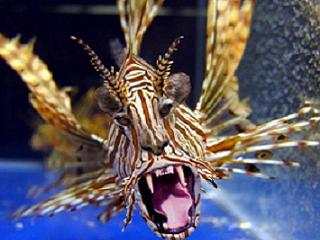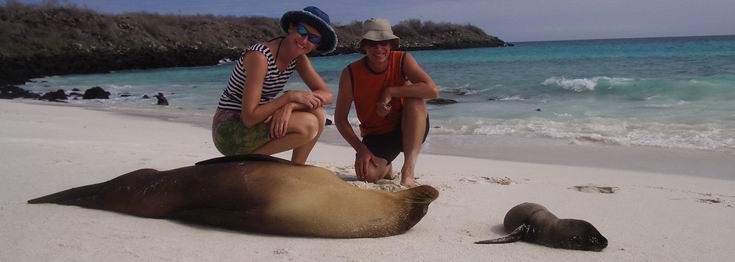|
|
|
|
Oct 25 – Nov 14, 2006 Quito – Galápagos Islands – Baños – Quito – Otavalo |
|
|
As we promised in the last update, our following escapades feature: The Long Lad Far Away from Home! Armed with our 6-month backlog of mail and a youthful spirit of adventure, Darina’s brother Karol arrived in Quito after 17 hours of airports and airplanes. |
|
|
Soon afterwards he was marched off into Quito’s old town for a dose of South American culture. Quito was, in its day, the second most important Inca city after Cusco. Then with the arrival of the Spaniards it became one of their earlier centers of settlement. Today we can enjoy numerous churches, domes, spires, plazas and arcades in this UNESCO World Heritage site. |
|
|
La Compañia de Jesús church |
Quito boasts the most beautiful baroque church in South America. The Compañia de Jesús Jesuit church indeed surpasses in décor and affluence anything we have seen to date. Even though it’s rich enough to decorate 10 churches amply, it’s still tastefully and harmoniously done.
|
|
Domes abound in the old town |
|
|
Culture ticked off, it was time to chase the long lad up a volcano. Standing at 4,800masl, overlooking Quito, Ruco Pichincha was a breeze for our well trained Moydow Harper … and the hailstones near the summit made him feel quite at home!
|
|
|
Next on the list was a visit into evolutions laboratory. Situated 1,000km off shore in the Pacific Ocean, the Galápagos Islands have to be seen to be believed. |
|
|
|
|
| Isolated for millions of years, whatever species made their way to these unique volcanic rocks had more than enough time to evolve and occupy various ecological niches. | |
|
Darwin finch |
Today, there are 13 species of finches, for example, (each and every one with a different beak to deal with different foods), although they all had a common ancestor. This is what led Charles Darwin to his theory on evolution and his ground-breaking publishing of “The Origin of Species”. To us it makes a whole lot of sense now, but 150 years ago it was quite a feat to come up with such a theory.
|
 |
|
|
Now that's evolution for you! |
|
|
We flew to Baltra, near Santa Cruz Island and our first excursion was to Isabela Island, the largest of the Archipelago. The 2-hour roller-coaster boat ride was a horrendous ordeal for everyone except Karol, who had sneaked in a weekend’s training on the River Shannon before joining us. |
|
|
The next day we sat the lad on a horse and rode around Sierra Negra, the second largest volcano crater in the world, with a diameter of 10km. After last year’s spectacular eruption, the crater has a fresh black lava shine and a few fumaroles are still puffing. |
|
|
Lunar landscape on Volcán Chico |
It was a short hike over lava fields and tunnels to Volcán Chico, where the lunar landscape was a blaze of colour and form. |
|
Back on Santa Cruz Island, we boarded a 20-passenger boat for a 5-day cruise including the southern islands. Our itinerary included Baltra, Plazas, Santa Fe, Española and Floreana Islands. The trip was all inclusive and we spent the next few days with a pleasant international bunch sailing, swimming, snorkeling, sunbathing, animal spotting and bird watching.
|
|
|
What a pose! |
The Galápagos are famous for their barren landscape, white sand beaches, crystal clear waters and unique fearless animals and birds. They are so tame and inactive you have plenty of time to find the perfect angle for that prize shot or to take 100 snaps for editing at a later date! No excuses for lousy photography here! |
|
Sea lions were probably the most omnipresent. Lounging on beaches, boats, park benches and rocky outcrops… they seem to have their life all sorted. They're probably the easiest subject to photograph, but are at their best when they approach your snorkeling mask under water and initiate a playful session.
|
|
|
|
|
|
Land iguana |
Iguanas come in all sizes and colours from the big black marine iguana, to the yellow and red/green land variety and the tiny lava lizards. |
|
They look like a prehistoric life form and because no one developed a taste for them, they’re all over the place. They can measure up to 1.5m and tend to soak up the sun in a collective fashion, not unlike Brits on the Canary Islands! |
|
|
|
|
|
Blue-footed boobies |
The blue-footed boobies are the stars of the show as far as birds go. Not alone do they have the weirdest colour of feet, but their mating ritual is quite something to watch. They put on a slow motion dance (without tripping over their webbed feet), throwing in a few bows and wing movements for good measure. |
|
The waved albatross, with a wing span of up to 2.4m, is Kurt’s favourite, because they too have blue feet and an eyebrow like Uncle Sam! (The mind boggles!) Their courtship involves beak noises not unlike chop sticks and serious bill rapping akin to head banging. To see them sail is just the most majestic sight to behold.
|
|
|
|
|
|
Greater flamingoes |
The greater flamingos found a few lagoons to dredge for shrimps, giving them their characteristic pink colour and a few calories.
|
|
Originating from Antarctica, the tiny Galápagos Penguin is the most northerly in the world. They seem to just hang out on black rocks all day and go in for the odd dip! |
|
|
|
|
|
|
Snorkelling brought us closer to a few corals, lobsters, sea turtles, sea lions and a lot of colourful fish. The white tipped reef sharks didn’t grace us with their presence much to Karol’s dismay... but there was never a dull moment! |
|
The ancestors of the giant land tortoise probably made their way to the islands floating on their backs after some flash flood on the mainland. They subsequently evolved into the huge animals they are today because of an abundance of food and a lack of predators. They almost vanished from the face of the earth again because whalers and pirates found them convenient fresh food as they could survive a year without food and water. |
|
|
Gotcha! |
|
|
Cactus detail |
|
| Our trip to Galápagos is certainly one of our South American highlights, even if it took us a couple of days to stop the earth from moving under our feet, once back on land! | |
|
|
|
|
The Farrells far away from home! |
The main backpacker hangout and adventure centre of Ecuador is Baños. Shadowed by an active volcano, erupting at frequent intervals, Baños town has been protected from disaster to date by their local virgin. We took off on rented bikes, direction Puyo, past 100s of waterfalls and a few tropical fruit farms. |
|
We crossed rivers on questionable cable cars…
|
|
|
You can't leave me now! |
...abseiled down waterfalls (or rather... we sent Karol down!)... |
| ...gorged on passion fruit ... |
|
|
Time for a wash... |
...and generally enjoyed the sights in glorious weather. The local hot springs were a perfect relaxing end to the day. However, Karol had a big white water rafting adventure ahead…. |
|
Back in Quito, Karol shopped till he dropped…so you'd better appreciate the presents he brought home! |
|
|
Seafood, beans, rice & milk shakes |
A few more dinners and Karol was back on the plane for another 17-hour ordeal. It was lovely to have a visit from home and we enjoyed our little holiday from the bikes with him. Cheers Karol!
|
|
We ran out of excuses to hang out any longer in Quito, so we packed our bikes and headed north under our own steam. Back in the mountains, cut apart by deep valleys, we were washed out by afternoon rains and quickly reminded what climbing entails. |
|
|
|
|
|
The main plaza, Otavalo |
Now, we are enjoying Otavalo and its wonderful, colourful markets, traditional costumes and laid back atmosphere. This is our last big town in Ecuador and it seems a grand place to wrap up our 2-month sojourn.
|
|
|
|
|
Markets in Otavalo |
|
|
One thing that struck us while in Ecuador was how difficult many people find it to make ends meet. The local currency changed to the US dollar in the year 2000. However, no adjustment was made to salaries to compensate for the price hikes involved. Teachers, for example, earn on average US $300-400 a month, which is less than what they can make driving taxis. Many dream of emigrating and the traffic of Ecuadorians as cheap labor abroad is quite the issue. Let’s hope the presidential elections of Nov. 26 will result in a fairer distribution of wealth. |
|
|
|
|
|
Traditional costume |
|
|
For the tourist, Ecuador is one of those unique countries that have many contrasts of landscape in a “small” area. With the Pacific coast, the Andes and volcanoes, the Amazon jungle and the Galápagos Islands to top it all off, Ecuador is a right little paradise right in the centre of the world. We have thoroughly enjoyed our time in Ecuador and would highly recommend it as both a holiday and touring destination.
|
|

